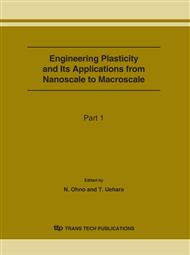p.229
p.235
p.241
p.247
p.255
p.263
p.269
p.277
p.283
Dynamic Tensile Characteristics of TRIP-Type and DP-Type Sheets for an Auto-Body
Abstract:
This paper investigates the dynamic tensile characteristics of TRIP600, TRIP800, DP600 and DP800 at the range of strain rate from 0.003 to 200/s. The tensile test acquires stress−strain curves and the strain rate sensitivity of each material. Experimental results show two important aspects for TRIP-type and DP-type sheets quantitatively: the flow stress increases as the strain rate increases; the elongation is not a monotonic function of the strain rate and increases at the same level of the strain rate even when the strain rate increases. In order to investigate the pre-strain effect for two types of metals at the high strain rate, TRIP600 and DP600 were elongated with the pre-strain of 5 and 10% at the strain rate of 0.003/s. Then, dynamic tensile tests were carried out at the strain rate of 0.003, 1, 10 and 100/s. The results demonstrate that the material properties of TRIP600 and DP600 are noticeably influenced by the pre-strain when the strain rate was over 1/s. The ultimate tensile strength as well as the yield stress increases due to the pre-strain effect.
Info:
Periodical:
Pages:
255-262
Citation:
Online since:
June 2007
Authors:
Price:
Сopyright:
© 2007 Trans Tech Publications Ltd. All Rights Reserved
Share:
Citation:


